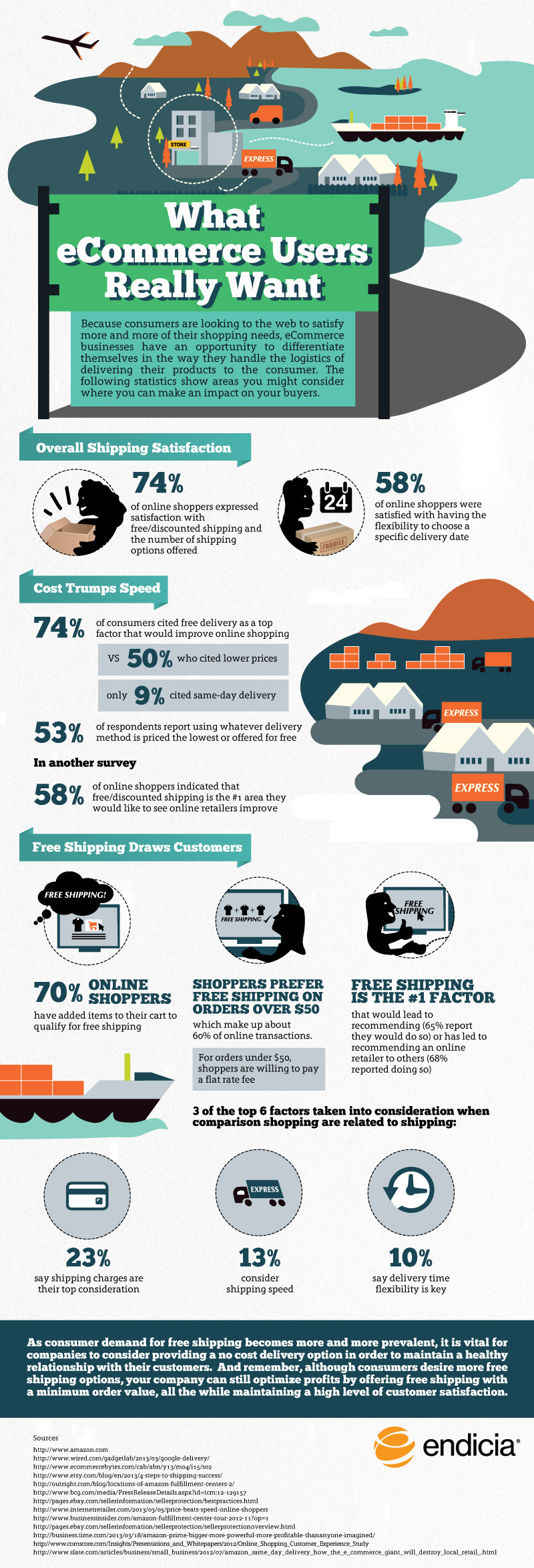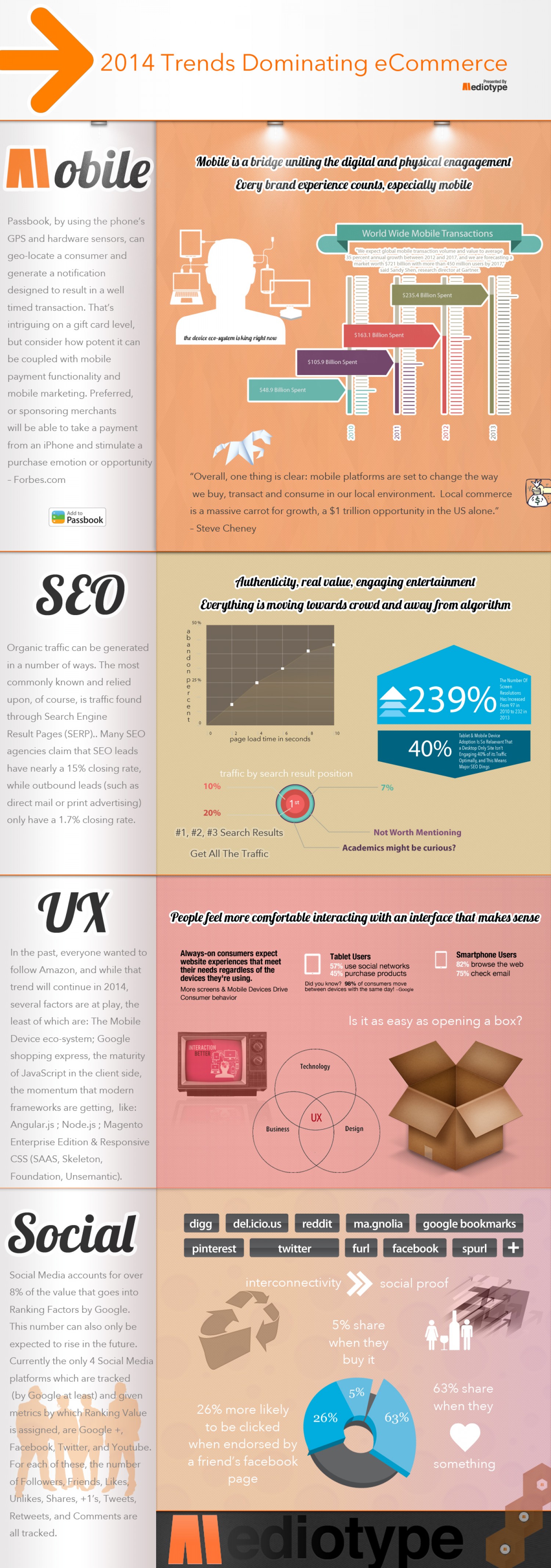Resources
![]() Customer Acquisition & Engagement
Customer Acquisition & Engagement
eCOMMERCE TRENDS & FORECASTS
The Tipping Point (eCommerce Version) — Jeff Jordan, Re/Code
The retail world is changing, and we’re seeing creative destruction play out before our eyes. And the speed at which it is happening is absolutely stunning. UPS and FedEx had better start building out their fleets, big time — these trends are only accelerating.
Hello, Smart Commerce — Bill Ready, PandoDaily
Five years ago this would’ve sounded like science fiction. Today it’s looking more like our mobile commerce reality. I call it the Smart Commerce movement, and it’s driving some major behavioral shifts.
Smartphones Are Making Shopping More Fun — Jeremy Liew, PandoDaily
The old model of ecommerce was all about converting visitors into customers based on a per-visit view. The focus was on funnel management, on waterfalls and conversions at each step, as though it was an enterprise sales pipeline. Everything was done to get a visitor to put something into a shopping cart, then to check out. This new model takes a radically different approach. If a user doesn’t become a customer right away, it doesn’t matter. What matters is that she comes back often and spends more time with your app, looking at products. Engagement becomes the key driver.
The 3rd Wave Of eCommerce Disruption: Emotional Commerce — Jason Goldberg, Betashop Quarterly
The first wave of e-commerce — which was dominated by Amazon — was all about bringing commodity products online. I like to call this wave: Commodity Commerce…The second wave of e-commerce — which is a battle between Apple, Amazon, Netflix, Google, and others — is the digitization of media. Digital Commerce. Books. Music. Movies. TV. Video…The third wave of e-commerce is all about bringing emotional purchases online. Non-commodity products. More thoughtful purchase decisions. I like to call thisEmotional Commerce. This is categories like furniture, home accessories, home textiles, fashion, art, and jewelry. These are categories where people care about having something special in their lives.
The Future Of Business Models — Jeremiah Owyang, Slideshare
Learn how people’s needs have changed, resulting in changes in future business models. This illustrated storyboard makes it easy to understand.
A Warning To eCommerce Startups: The Future Of Online Is Offline — Pratik Dholakiya, The Daily Egg
Something a bit unexpected happened: the mobile revolution. While some may have seen bits and pieces of it coming, nobody could have foreseen the way it would influence our daily lives. Rather than migrating into the digital world, we’re bringing the digital world into ours. The future of online is offline.
Online Retailers Move Into Bricks-And-Mortar Stores — Lindsay Baker, BBC News
In a new twist, established e-commerce businesses are increasingly opening physical stores. This emerging trend, labelled “clicks to bricks” or “e-tail to retail”, looks set to inject some much-needed vigour back into local High Streets. “It is one of the ironies of our time that a digital medium, the internet, is making the in-person shopping experience a more humane one,” [Bonobos CEO Andy Dunn] says.
5 eCommerce Challenges for 2014 — Armando Roggio, Practical eCommerce
Retailers should not rest on their current success, but rather should challenge their businesses to improve in several areas, including free shipping offers, mobile optimization, personalization, data driven decision making, and cross channel sales.
ATTN: eCOMMERCE STARTUPS
eCommerce Is A Bear — Andy Dunn, Medium
I observe four strategies in the marketplace to deal with Amazon’s incumbency: proprietary pricing, proprietary selection, proprietary experience, and proprietary merchandise…This next generation of e-commerce companies is as much about what youexclude as what you include. It is a paradox that excluding some things takes more time than including everything.
The Alternative Commerce Recipe — Neil Sequeira, TechCrunch
Follow your alternative commerce dream, but also follow a few simple rules — many of which come down to business fundamentals — and you, too, can create a great company that doesn’t just ship products but focuses on creative business models, alternative distribution channels, brand and loving your customer. With the right recipe, it can indeed be a piece of cake.
Defining An eCommerce Org Structure — Joe Rozsa, JoeRozsa.com
One of the first things I’m often asked at the beginning of an engagement is “How should our organization be structured?” Many eCommerce businesses are not set up in a very efficient manner, including many large companies. Regardless of the size of your eCommerce team, there is a structure that can be used to group functionality and tasks so that the work gets done in the most efficient manner possible.
Platform Payments 101 — WePay
Class is in session! Your service connects buyers and sellers, and you want to learn more about payments. This multi-chapter Payments 101 tutorial will help you discover the realities of facilitating payments on your platform.
MARKETPLACE MOVES
All Markets Are Not Created Equal: 10 Factors To Consider When Evaluating Digital Marketplaces — Bill Gurley, Above The Crowd
A true marketplace needs natural pull on both the consumer and supplier side of the market. Aggregating suppliers is a necessary, but insufficient step on its own. You must also organically aggregate demand. With each step, it should get easier to acquire the incremental consumer AS WELL AS the incremental supplier. Highly liquid marketplaces naturally “tip” towards becoming a clearinghouse where neither the consumer nor the supplier would favor an alternative.
Rebellion In The Marketplace: Why Vertical eBays Are Springing Up & Gaining Traction — Carmel Deamicis, PandoDaily
Ebay is facing a long, slow death by a thousand cuts, as vertical marketplaces are pulling its business out from under it. Although verticals might not work for social networks — no one uses a “Facebook for dog lovers” for example — it’s working for resale sites.
DESIGNING FOR CONVERSION
The $300 Million Button — Jared M. Spool, User Interface Engineering
It’s hard to imagine a form that could be simpler: two fields, two buttons, and one link. Yet, it turns out this form was preventing customers from purchasing products from a major e-commerce site, to the tune of $300,000,000 a year. What was even worse: the designers of the site had no clue there was even a problem.
4 UX Mistakes That Are Killing Your Conversions — Sean Ellis, Web Designer Depot
As user experience professionals, we’re on the front lines of this new CRO imperative. We’re asked to run tests, design new user flows, and rapidly prototype new page layouts all in the name of increasing conversion rates. But as keeper of the user experience, it’s critical that we bring the big picture view of UX strategy to the table and ensure that CRO tests are appropriate within the overall user experience framework. [In this piece, I outline] four mistakes that many organizations make when it comes to CRO and UX.
An eCommerce Study: Guidelines For Better Navigation & Categories — Christian Holst, Smashing Magazine
Product findability is key to any e-commerce business — after all, if customers can’t find a product, they can’t buy it. Therefore, at Baymard Institute, we invested eight months conducting a large-scale usability research study on the product-finding experience. We set out to explore how users navigate, find and select products on e-commerce websites, using the home page and category navigation.
Web Design 101: How Typography Affects Conversions — Ankit Oberoi, Entrepreneur
Typography is crucial because it can make the whole process of understanding and comprehending information effortless. A typographically well-formatted copy ensures that the focus remains on the content and not on the effort required to read it.
[Email] Subject Line Data: Choose Your Words Wisely— MailChimp Report
Most people quickly scan the subject lines in their inbox before deciding which messages are worth their time and attention. With so much pressure on the subject line to entice the potential reader, we thought it would be interesting to see how much of a difference a single word can make in a campaign’s open rate. To get some answers, we studied approximately 24 billion delivered emails with subject lines composed of approximately 22,000 distinct words. If you think that sounds like a lot of data, you’re right.

CUSTOMER ACQUISITION & ENGAGEMENT
Startup Drugs — Andy Dunn, PandoDaily
What does advertising have to do with this? It’s the crack. It becomes more and more addictive as you use it. As one of my lead investors —the Oracle — once told me: “Spending a lot of money on paid marketing is a great way to scale a bad business.”
The Ultimate Guide To Customer Growth — Sean Johnson, SlideShare
Sean Johnson discusses tactics and strategies for driving customer growth by optimizing each stage of the customer development funnel.
13 Amazing Abandoned Cart Emails (And What You Can Learn From Them) — Dan Wang, Shopify
We shared an astonishing fact a little while ago that comes from a roundup of studies: 67.45% of online shopping carts are abandoned before the customer completes a sale. That implies that your sales numbers may only be one third of what they could potentially be. Today we want to zoom in on one of the most effective ways to recover lost customers after they abandon their carts: the Email Recovery Campaign. Then we’ll share the tools you need to set one up for yourself.
Giving eCommerce Customers What They Want [Infographic] — Linda Lacina, Entrepreneur
eCommerce is a $231 billion industry. To compete, companies need to suss out customers’ changing wants and needs and adjust their logistics programs to match. This infographic breaks down what shoppers value in online shopping so your company can plan accordingly.
Customer Service In eCommerce: Challenges & Solutions — Pawel Grabowski, eCommerce Insiders
Providing a good customer service is one of the key challenges on any online business. Since you, as an owner, are not right beside the customer while she shops, there isn’t much you can do to help her with the process. Have you ever thought about how it is to be a customer of your store? Do you think you provide a good customer service?
Give The Consumers What They Want: Video [Infographic] — Daniela Forte, Multichannel Merchant
Both retailers and consumers value video, but fulfilling shoppers’ expectations is what ultimately leads to success. Where do retailers’ beliefs about video match up to consumers’ needs, and where do they fall short?
How To Start Using Video In eCommerce — Pawel Grabowski, eCommerce Insiders
A sense of ownership is what often motivates people to buy. Yet, it is hard to offer it to online visitors who simply can’t physically try the product or hold it in their hands. You can replicate some of this feeling though with the use of imagery and most importantly, a video.
Gamification & eCommerce — Joseph Yi, eCommerce Rules
Whether you’re into video games or not, you cannot ignore the behemoth known as the video games industry. In last year alone, the gaming industry saw over $63 billion dollars in revenue, and trends suggest that there is nowhere to go but up for the future. Many non-gaming companies have already noticed the power of gaming and are using gaming experiences to build their brands…There’s a good chance that you have played in a game constructed by one of the many brands you interact with.
OPERATIONS & SALES
7 Questions Before You Buy Software Or Services — Armando Roggio, Practical eCommerce
Ecommerce platforms, accounting suites, product review systems, live chat solutions, email marketing providers, search engine optimization agencies, fulfillment and logistics specialists, and contract customer service centers are just a few examples of the software or services that an online retail business can lease, license, buy, or otherwise acquire. Here is what to ask yourself or, perhaps, even ask the person trying to sell you something.
Why You Need A Retargeting System For Your eCommerce Page — Joseph Yi, eCommerce Rules
Say that a person went to your website, browsed some products, and failed to make a complete checkout. If you don’t make any further efforts to win the customer back, that lead is probably gone for good. Retargeting exists to give you a chance to get that lead back and successfully convert him or her. In a study conducted earlier this year, Criteo found that using retargeted ads for your site can raise your conversion rate by nearly 70 percent.
Study: Retailers Lose 73% Of Sales To Shopping Cart Abandonment — Pete Rizzo, PYMNTS.com
Nearly 25 percent of top eCommerce companies are sending shopping cart recovery emails in an attempt to recapture lost revenue opportunities, a newly released report from Listrak revealed on October 17…”A shopping cart recovery campaign can recapture those lost sales, adding revenue directly to an online retailer’s bottom line,” the report authors concluded.
The Marketplace Fairness Act & You — Joseph Yi, eCommerce Rules
Brick and mortar stores already collect sales tax based on local tax code rates and pretty much just serve the immediate community around them. On the other hand, ecommerce sites work across the entire country and currently just collect tax for in-state customers (in-state defined as an ecommerce store having a physical address in the same state). If the act is passed, state governments should see over $10 billion in tax revenue from online sales. The bill is still technically up in the air, as the House of Representatives hasn’t voted on it and President Barrack Obama has yet to sign it into law, but he has shown strong support for it. Here’s what you need to know about this piece of legislation.
Supreme Court Declines Case On Making Online Retailers Collect Sales Taxes — Robert Barnes, The Washington Post
The multibillion-dollar issue — which could end tax-free online shopping for many Americans — is one of the most important in modern retailing. Traditional bricks-and-mortar businesses say the online retailers receive an unfair advantage by not having to collect sales taxes in some areas. The court’s decision to stay out of the issue for now may put more pressure on Congress to come up with a national solution, as both online and traditional retailers complain about a patchwork of state laws and conflicting lower-court decisions.
CASE STUDIES
My Reaction To Zulily’s IPO Filing And Flash Sales Explained — Greg Bettinelli, #Long LA
This week Zulily, the ecommerce flash-sale site targeting moms with products for their kids and themselves, filed their S-1 to go public. While I knew the filing was coming and I had an idea what would be inside, my first reaction was still……HOLY SHIT. Without a doubt, the 179 SEC page filing is a must-read for ecommerce investors and entrepreneurs everywhere. The reason: on one extreme it highlights how well they have executed on an incredibly tough business in just four short years, going from a zero to $600 million in annual sales (my estimates for 2013). On the other extreme, they have limited profits and have lost $56 million to get to this point in their life-cycle. In between, there is a ton of interesting and pertinent information.
It’s Adapt-Or-Die Time For Daily Deals Firms: The Squeeze Is On — Christopher Heine, Adweek
In 2009, daily deals firms sprouted up on the digital landscape like eager-to-bloom crocus flowers often seen at this time of year. But more recently a late winter freeze has buzz sawed through one flowery bulb after another, as hundreds of daily deals upstarts have fallen by the wayside because they couldn’t develop in the harshly competitive climate.
Bonobos Opens Stores That Don’t Sell Anything — Oliver St. John, USA TODAY
Bonobos, (say “bu-NO-bos”) Guideshops are men’s clothing stores that basically don’t sell anything. Customers can try stuff on for size, put outfits together and get advice from salespeople. But if they like it, they’ve got to order it on the Bonobos website. This small store is a big deal. If other stores catch on — and it may be more of a question of when than if — this could ultimately change the business model for the nation’s 895,800 retail establishments.
Honest Co. Enters the eCommerce Big Leagues With A $25M Round. Here’s How It Got There — Michael Carney, PandoDaily
Building an ecommerce company is expensive. It’s also binary. Companies either find success and experience massive growth, and thus are able to attract capital to chase scale and sustainability, or they sputter along until eventually running out of cash. Honest has succeeded in leveraging four of the key trends of this ecommerce 2.0 era: brand-first, celebrity, subscription, and brick-and-mortar distribution.
Refinery29 Ditches Commerce, Raising $20 Million To Double Down On Content — Erin Griffith, PandoDaily
Like any good startup, Refinery is doubling down on what’s working and moving away from what’s not. The commerce element will no longer be a focus. “It took us a couple of years to come to the conclusion that we could provide a better resource to users by focusing on discovery … versus getting caught up in the native transaction,” [Co-CEO Philippe] von Borries says. Dealing with tedious things like inventory, transactions, and shipping is a lot less appealing when the other side of the business — making content that readers and brands love — comes more naturally.
Why A Jewelry Startup Had To Build Enterprise Software To Survive — Erin Griffith, PandoDaily
These seller-generated storefronts look seamless, but the functionality was a bitch to build. [Chloe & Isabel CEO Chantel] Waterbury says she expected to meet with a few software providers, pick the best option, install it and go back to dealing with jewelry. No such luck. It just wasn’t available. “We didn’t need 90 percent of the stuff they were offering, and when we told them what we did need — integration with social, curation tools, individual boutiques and analytics — they had nothing,” she said. “I realized, oh my god, we’re going to build this from scratch.”
We’ve Entered The Age Of Emotional, Design-Centric eCommerce — Katie Fehrenbacher, Gigaom
Everlane and True & Co are creating new online e-commerce experiences, and they’re using emotion and design to do it. Warby Parker has famously grown its online glasses business in this way, too…The lesson for e-commerce startups, product developers, website designers, and anyone else building something that other people will be using — in the physical world and the digital world — is that the small details matter. A lot.
BITCOIN BANTER
Why Bitcoin Matters — Marc Andreessen, The New York Times
The practical consequence of solving this problem is that Bitcoin gives us, for the first time, a way for one Internet user to transfer a unique piece of digital property to another Internet user, such that the transfer is guaranteed to be safe and secure, everyone knows that the transfer has taken place, and nobody can challenge the legitimacy of the transfer. The consequences of this breakthrough are hard to overstate.
On The Matter Of Why Bitcoin Matters — Glenn Fleishman, Medium
Marc Andreessen wrote an essay for the New York Times about Bitcoin, “Why Bitcoin Matters,” in which he attempts to explain the relevancy of the digital currency for the future of commercial transactions. He uses analogies, allegories, history, and ostensible facts to build his case. However, I believe he fundamentally misrepresents or misunderstands key aspects of the technology, ecosystem, and impact.
Bitcoin 2014 — Top 10 Predictions — Lightspeed Venture Partners
These predictions are based on growth patterns of similar networks, the traction in various ecosystem activities last year, and my conversations with various Bitcoin enthusiasts.
The Face Behind Bitcoin — Leah McGrath Goodman, Newsweek
I’d come here to try to find out more about Nakamoto and his humble life. It seemed ludicrous that the man credited with inventing Bitcoin - the world’s most wildly successful digital currency, with transactions of nearly $500 million a day at its peak - would retreat to Los Angeles’s San Bernardino foothills, hole up in the family home and leave his estimated $400 million of Bitcoin riches untouched. It seemed similarly implausible that Nakamoto’s first response to my knocking at his door would be to call the cops. Now face to face, with two police officers as witnesses, Nakamoto’s responses to my questions about Bitcoin were careful but revealing.
















